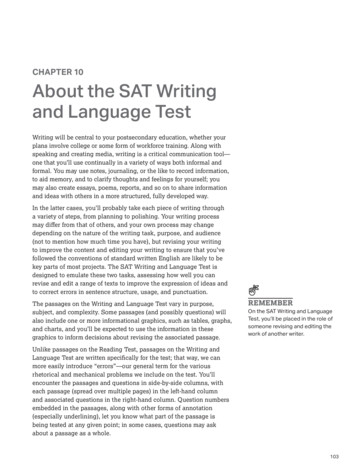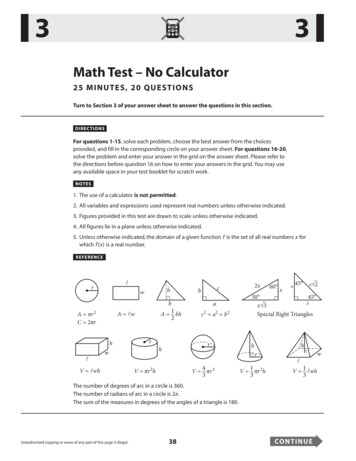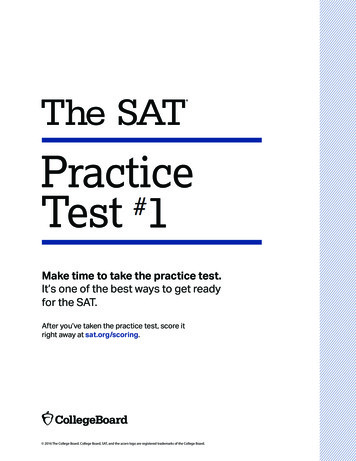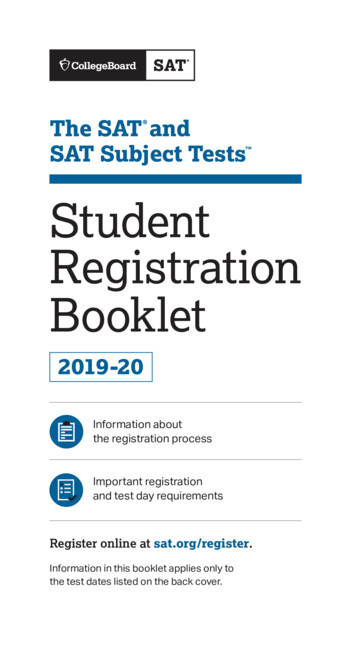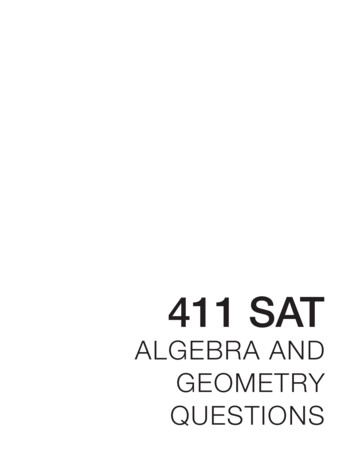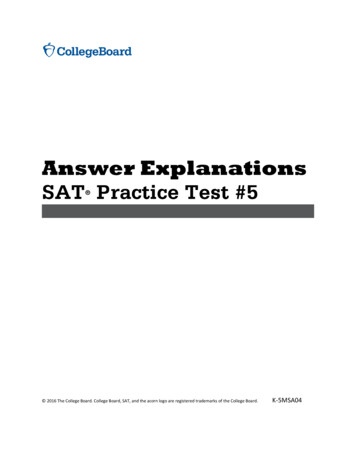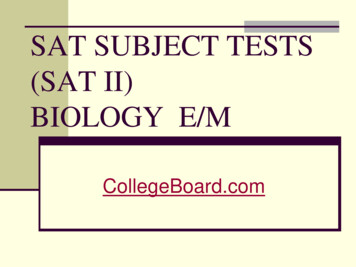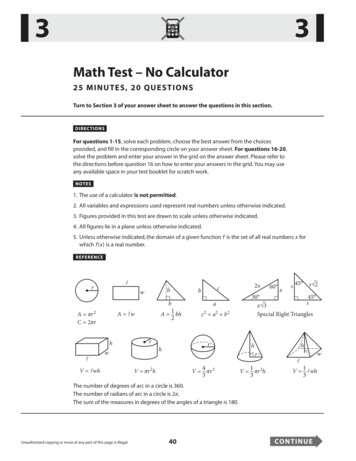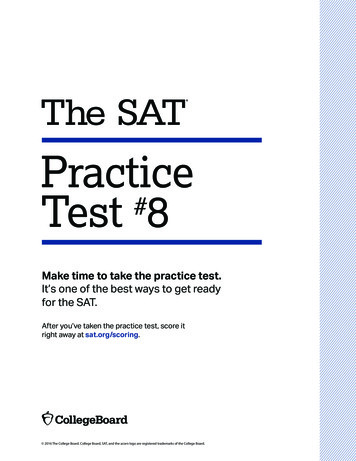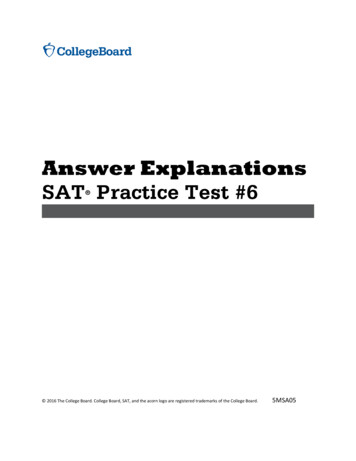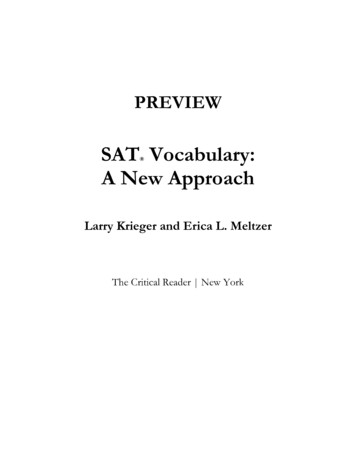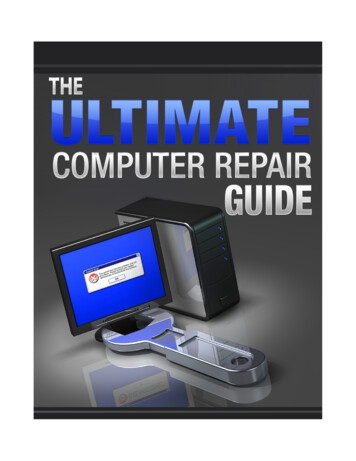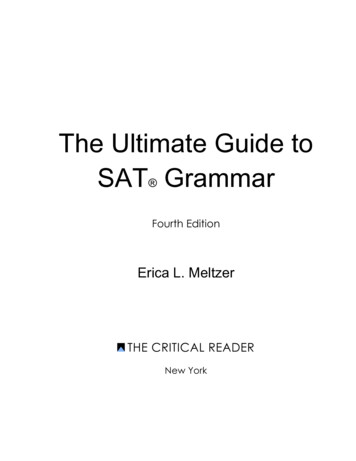
Transcription
The Ultimate Guide toSAT GrammarFourth EditionErica L. MeltzerNew York
Copyright 2011-2017 Erica MeltzerCover 2017 Tugboat DesignAll rights reserved.No part of this publication may be reproduced in any form or by any means, electronic or mechanical, includingphotocopy, recording, or any information storage and retrieval system, without written permission from the author.For information, please send correspondence to thecriticalreader1@gmail.com.SAT is a trademark registered by the College Board, which is not affiliated with, and does not endorse, thispublication.ISBN- 13: 978-0-9975178-6-6ISBN-10: 0997517867
DEDICATIONTo Emma and Joey, for whom these exercises were first written. I know you never asked to have agrammar book dedicated to you, but I hope you’ll accept the gesture. And to Jane, Joe, Lily, and Frisco,for food, company, inspiration, and hilarity.
Table of Contents.Introduction: How to Use This Book7SAT Writing Cheat Sheet8Parts of Speech9Preliminary Exercise121.Is it Relevant? Adding, Deleting, and Revising162.Sentence and Paragraph Order313.Infographics404.Shorter is Better535.Diction, Idioms, and Register616.Sentences and Fragments717.Combining and Separating Sentences:Periods, Semicolons, Commas, and Conjunctions858.Transitions959.Non-Essential and Essential Clauses11310.Additional Comma Uses and Misuses13411.Colons and Dashes13912.Question Marks: Direct vs. Indirect Speech14313.Apostrophes: Plural vs. Possessive14414.Pronoun and Noun Agreement153Cumulative Review: All Punctuation and Transitionsv150
14.Verbs: Agreement and Tense17015.Word Pairs and Comparisons19316.Parallel Structure20017.Dangling and Misplaced Modifiers21018.Relative Pronouns: Who(m), Which, That, Where & When218Practice Test227Answer Key240Appendix A: Official Guide Questions by Category253Appendix B: Official Guide Questions by Test258About the Author263vi
Introduction: How to Use This BookThis purpose of this book is to prepare you for the full range of grammar and rhetoric (style) conceptscovered on the redesigned SAT . More specifically, it is to teach you to apply those concepts to the specificways in which they are tested on the exam. Instead of providing explanations and examples for a singleversion of a rule and leaving you to deduce its subtler or more complex applications, this book walks youthrough multiple iterations of each concept, showing you how it can be tested from various angles and incombination with other concepts.At the same time, however, this book is intended to teach you to simplify – that is, to quickly identify justwhat each question type is testing so that you do not become distracted by irrelevant details, and to reduceseemingly complicated questions down to their essential terms. Concepts guaranteed to be tested on everyexam are presented first, while less frequently tested ones are presented later. In addition, concepts thatcould plausibly be tested but that have not (yet) appeared on a released exam are noted as such in the text.In order to make your transition to the actual test as smooth as possible, this book is intended tocomplement the eight official College Board Guide/Khan Academy practice -totake-on-paper).If you have a limited amount of time to prepare for the SAT, you should work as follows: take a CollegeBoard practice test as a diagnostic. Mark your errors, and compare them to the list of questions by test onp. 258. Note the category of each error. Then, read the explanations in the appropriate chapter, and do thecorresponding exercises. If you want to look at some authentic examples as well, you can use the list ofquestions by category on p. 253 to find specific Official Guide/Khan Academy questions that test particularerror types. When you feel you have a good grasp of those concepts, take another test and repeat theprocess. Keep working this way until you are consistently scoring in your target range on full-length, timedexams.If you do not plan to sit for your first exam for a while, however, I strongly encourage you to work throughthis book in order. While that approach will obviously require more time, it will also allow you to acquire avery solid foundation. Knowing why you are answering questions correctly – rather than simply relying onyour ear – will improve both your speed and your confidence. Otherwise, you risk second-guessingyourself if a concept is tested in an unfamiliar way.While the College Board is still in the process of making adjustments to the redesigned exam, the Writingand Language Test is likely to remain one of its more predictable components. It is of course possible thatthe particular exam you take will contain a “wild card” question or two, but in general, the vast majority ofthe material tested can be safely anticipated. The goal of this book is to teach you how to anticipate it.-Erica Meltzer7
SAT Writing Cheat Sheet1. Shorter is better (grammar questions only).2. Comma it, this, he, she, they usually (but not always) comma splice WRONG.3. Period semicolon comma and/but.4. 2 commas/2 dashes/2 parentheses non-essential clause. If the information between thesepunctuation marks is crossed out, the sentence will still make sense.5. Its, their possessive; it’s it is; they’re they are; there a place.6. Colon list or explanation. A complete, standalone sentence is required before but not after.7. All items in a list must match (noun, noun, noun; verb, verb, verb, etc.).8. Comma before preposition WRONG.9. Being WRONG.10. Affect verb, effect noun; than comparison, then next.11. Singular verbs end in –s; plural verbs do not end in –s (e.g. she reads, they read).12. Keep verb tense/form consistent. An underlined verb should stay parallel to the surrounding verbsunless there is a clear reason for the tense to change. Check verbs in the sentence/paragraph forcontext.13. Add/Delete/Revise: Reread the surrounding sentences, and state the topic in your own words beforechecking the answers. If the sentence is directly relevant to that topic, it belongs. If not, it doesn’tbelong.14. Transition questions: Cross out the transition and determine the relationship (continue, contradict,cause-and-effect) between the two sentences/parts of a sentence before checking the answers.Eliminate answers that are synonyms for one another as well as answers from the wrong transitioncategory.15. Infographics: Take a moment and determine the “point” of the graphic before you start to answer thequestion. You can sometimes eliminate answers based on a big-picture understanding.And two general points:First, make sure you actually read the passage. You don’t need to read closely, but you shouldn’t just skipfrom question to question. Otherwise, you’re likely to miss information you need to answer questions.Second, before you choose an answer, plug it back into the passage to make sure that it fits. An answerthat makes perfect grammatical sense on its own may create an error in the context of the passage.8
Parts of SpeechThere are eight parts of speech in the English language, seven of which are directly relevant to the SAT. Ifyou are not comfortable identifying them, you should begin by reviewing this section. Although portions ofthese definitions are repeated throughout the guide, familiarizing yourself with these terms before youbegin will help you move through the explanations and exercises more easily.The seven parts of speech tested on the SAT are as follows:1. VerbVerbs indicate actions or states of being.Examples: To beTo haveTo seemTo goTo speakTo believeThe “to” form of a verb is known as the infinitive. All of the verbs listed above are infinitives. If youare uncertain whether a word can be used as a verb, try placing to in front of it to form an infinitive.Verbs are not always used as infinitives. In order to indicate who is performing an action, we mustconjugate the verb and provide its subject.To be and to have are the most common English verbs; as a result, they are tested frequently on the SAT.Because they are irregular, their conjugated forms are different from their infinitives. To be is alsounique in that it is conjugated in both the present and past. To answer many verb questions accurately,you must be able to recognize and distinguish between these verbs’ singular and plural forms.Conjugation of to be, present:Conjugation of to be, past:SingularI amPluralWe areSingularI wasPluralWe wereYou areYou (pl.) areYou wereYou (pl.) wereIt, s/he, one isThey areIt, s/he, one wasThey wereConjugation of to have, present and past:SingularI havePluralWe haveYou haveYou (pl.) haveIt, s/he, one hasThey have9
The number of a verb indicates whether is singular or plural. Singular verbs end in –s. Plural verbs donot end in –s.I, you, he, she, it, one speaks SingularWe, you, they speak PluralThe tense of a verb indicates when an action occurred.It is PresentIt would be ConditionalIt has been Present perfectIt would have been Past conditionalIt was Simple pastIt will be FutureIt had been Past perfectIt will have been Future perfect2. NounNouns indicate people, places, objects, and ideas, and can always be preceded by a(n) or the.Note that in addition to physical objects, nouns can refer to ideas/concepts and things that cannot betouched. These nouns, known as abstract nouns, frequently end in –ment, –tion, and -tude.Examples: bicycle, supervisor, Julia Child, Chicago, notion, development, latitude The girl rode her bicycle down the street to her house. In the theater, the dancer moved across the stage with her arms held above her head.3. PronounPronouns replace nouns.Examples: she, you, one, we, him, it(s), their, this, that, these, those, which, both, some, few, many Samantha loves basketball. She plays it every day after school. Marco walks to school with Sherri and Ann. He meets them at the corner.Personal Pronouns are often referred to in the following manner:Singularperson Ind2 person You3rd person S/he, It, One1stPluralperson Wend2 person You3rd person They1st10
4. PrepositionPrepositions are time and location words. They indicate where things/people are, where they’regoing, and when events happened. They are always followed by nouns.Example:The dog ran under the fence and into the neighboring yard in a matter of FromInInsideNearNext toOffOnOppositeOutsideTowardUnderWithWithout5. ConjunctionConjunctions indicate relationships between words, phrases, and clauses.Examples: and, but, however, therefore, so, although, yet, when, because, since Alice went to the dentist, but later she went to the candy store. Because it rained yesterday, the ceremony was held indoors.6. AdverbAdverbs modify verbs, phrases, and other adverbs. Many common adverbs end in –ly (e.g. slowly,loudly, strongly), but the SAT is primarily concerned with conjunctive adverbs: adverbs that serve astransitional words.Although many of these words have the same meaning as conjunctions, they can only be used at thebeginning of a sentence or clause.Examples:however, therefore, thus, hence, moreover, indeed, furthermore, subsequently Alice went to the dentist. However, she later went to the candy store. It rained yesterday; therefore, the ceremony was held indoors.7. AdjectiveAdjectives modify (pro)nouns and other adjectives.Examples: large, pretty, interesting, solid, wide, exceptional, smart, short, simple The big brown dog growled menacingly as we approached.11
Preliminary Exercise: Identifying Parts of Speech (answers p. 240)Directions: identify and write the part of speech (e.g. noun, verb, adverb) for each underlined word.Although igloos are usually associated withAlaskan Eskimos (Inuits), 1 . they have mostly been1.constructed by people who lived in the centralArctic and Greenland's Thule region. Other Inuit2.Peoples 2 . tended to use snow to insulate theirhouses, which were constructed 3 . from whalebone3.and hides.Traditionally, three types of igloos 4 . were4.constructed. Small igloos were constructed as5.temporary shelters 5 . and used only for one or twonights. These were built and 6 . used during hunting6.trips, often on open sea ice. Medium-sized iglooswere usually single-room family dwellings 7 . that7.housed one or two families. Often, several of theseigloos 8 . were located in a small area, forming an8.Inuit village. The largest igloos were normally built inpairs: 9 . one of the structures was a temporary9.structure for community feasts and dances, whilethe other was 10. intended for living. These igloos10.could be constructed from several smaller igloosattached 11. by tunnels.11.12
Today, igloos are used mostly for brief camping12.trips; 12. however, the principles behind theirconstruction 13. remain the same. The snow used to13.build an igloo must have enough strength to be cutand stacked correctly. The best snow to use for this14.14. purpose is snow blown by wind because 15. itcontains interlocking ice crystals, which increase15.the amount 16. of weight the ice can support.16.Because of snow’s excellent 17. insulationproperties, inhabited igloos are surprisingly17.comfortable and warm inside. Sometimes, a shorttunnel is constructed at the entrance 18. to reduce18.heat loss when the door 19. is opened. Animal skins19.can also be used as door flaps to keep warm air in.Architecturally, the igloo is unique 20. because20.it is a dome that can be constructed without an21. additional supporting structure. Independent21.blocks of ice lean on one another and are polishedto fit. 22. In the traditional Inuit igloo, the 23. heat22.from the kudlik, or stone lamp, causes the interior to23.melt slightly, creating a layer of ice that24. contributes to the igloo’s strength. In fact, a24
SAT Writing Cheat Sheet 8 Parts of Speech 9 Preliminary Exercise 12 1.Is it Relevant? Adding, Deleting, and Revising 16 2. Sentence and Paragraph Order 31 3.Infographics40 4. Shorter is Better 53 5. Diction, Idioms, and Register 61 6. Sentences and Fragments 71 7. Combining and Separating Sentences: Periods, Semicolons, Commas, and Conjunctions 85 8.File Size: 491KBPage Count: 24
